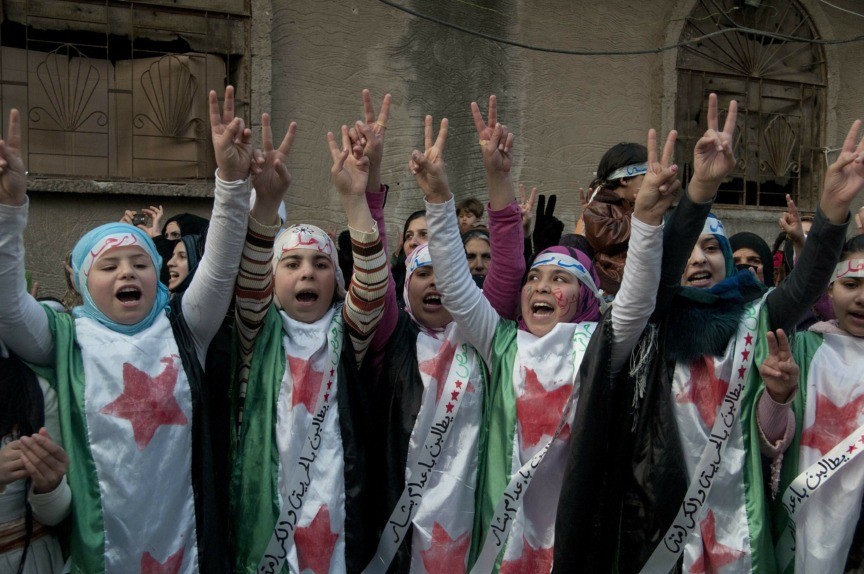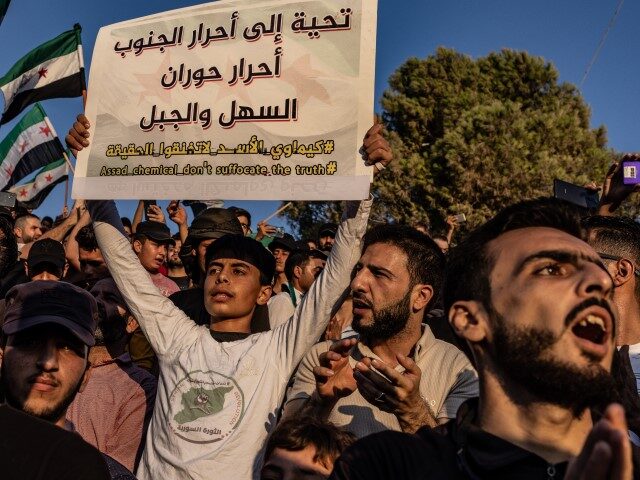An unusually energetic anti-government protest in southern Syria began its second week on Monday, with demonstrators burning dictator Bashar Assad in effigy, raiding the offices of his ruling Baath party, and hoisting the banner of the Druze minority.
Assad does not take criticism well, as Syria’s savage decade-long civil war testifies. The regime in Damascus has demonstrated its willingness to use starvation, indiscriminate barrel bombs, and chemical weapons to crush uprisings. The protests are happening not in some lingering rebel stronghold but in Sweida, a province the central government controls.
Foreign reporters noted that Syrian security forces have been curiously reluctant to crack down on the Sweida protests, even as demonstrators ransacked ruling party offices and loudly demanded Assad’s resignation. Security troops have fired live rounds to intimidate demonstrators, but no fatal shootings have been reported.
Sweida is heavily populated by the Druze, Syria’s third-largest religious minority. The majority religion in Syria is Sunni Islam, which comprises about 75 percent of the population. Assad and many members of the ruling elite are Alawites, an unusual offshoot of Shia Islam that counts about 13 percent of Syrians as members. Christians are about ten percent of the populace, and then come the Druze.
The Druze are distinct as both an ethnic group and a religion. As with the Alawites, their faith is an offshoot of Shia Islam that has its own ideas about who should be regarded as a holy prophet.
The Druze came up with an eclectic mix that includes Muhammad, Jesus, Plato, Socrates, and a few others – most notably an 11th-century Egyptian caliph named al-Hakim ibn Amr Allah, who is supposed to reappear at the end of days and reign over an era of worldwide peace and justice. Druze do not observe some classical Islamic rituals, such as fasting during Ramadan or making a pilgrimage to Mecca, and they have some of their own unique rituals and teachings. As with some of Syria’s numerous other offbeat religions, they do not recruit from outside their faith.
Hardcore Islamists tend to regard the Druze as heretics, so they have grown adept at protecting themselves from threats like the Islamic State. They were instrumental in the Baath party’s rise to power in the 1960s, but then largely neutral during the civil war that began in 2011.
This history might go some way towards explaining why Assad seems hesitant to put down the Druze uprising, which began with protests about Syria’s ailing economy and soaring inflation rates but has escalated into a serious challenge to the legitimacy of the regime.
The Associated Press (AP) suggested Assad might think his best course of action is to contain the protests in Sweida and hope they burn out:
In a scene that once would have been unthinkable in the Druze stronghold, protesters kicked members of Assad’s Baath party out of some of their offices, welded the doors shut and spray-painted anti-government slogans on the walls.
The protests have rattled the Assad government but don’t seem to pose an existential threat. They come at a time when government forces have consolidated control over most of the country. Meanwhile, Damascus has returned to the Arab fold and restored ties with most governments in the region.
[…]
For some, the final straw came two weeks ago when the Syrian president further scaled back the country’s expensive fuel and gasoline subsidy program. Assad also doubled meager public sector wages and pensions, but those actions did little to cushion the blow, instead accelerating inflation and further weakening the already sinking Syrian pound. The results further piled on the economic pressure on millions living in poverty.
Another reason for Assad to step carefully is that Sweida sits next to Daraa, the province where the civil war began in 2011. Protests have spread to Daraa, resulting in at least 57 arrests – but unlike 2011, security forces are not gunning protesters down in the streets.

In this Dec. 21, 2011 file photo, anti-Syrian regime protesters flash the victory sign as they wear Syrian revolution flags during a demonstration in the Baba Amr area, in Homs province, Syria. The Syria Justice and Accountability Center, a Washington-based Syrian rights group said in a report, released Tuesday, May 21, 2019, that thousands of documents collected from abandoned Syrian government offices reveal the reach of President Bashar Assad’s security agencies, offering a rare glimpse into the inner workings of his secretive apparatus. The documents include handwritten notes from top commanders to “do what is necessary” to quell anti-Assad protests. (AP Photo, File)
Assad likes to present himself as a defender of Syria’s minority communities, a posture that would be difficult to maintain if he ordered a Druze massacre. Conversely, he might be able to keep the protests from swelling into a nationwide uprising if he can portray them as a Druze movement.
Druze religious leaders have endorsed the protests, but have thus far refrained from calling on Assad to step down, a delicate neutrality that could end very quickly if Assad’s troops begin abusing the protesters.
Several Syrian analysts told the AP that Assad’s greatest fear would be other cities developing a sense of “solidarity” with the angry Druze and, since even residents of the capital city of Damascus are shelling out a month’s salary for a paltry handful of groceries, solidarity could take root very easily.
The most remarkable scene from Sweida came last week, when protesters not only kicked Baath Party officials out of their headquarters but welded the doors shut behind them. Numerous other party offices have been ransacked. Posters of Assad have been torn down and burned, a major offense against the dictator’s cult of personality.
“People have reached a point where they can no longer withstand the situation. Everything is crumbling,” Sweida journalist and activist Rayan Maarouf told the AP.
An influential Druze protest leader and former political prisoner named Suhail Thubian on Monday urged world leaders to invoke U.N. resolutions to insist that Assad step aside.
“Why does the international community still recognise him as head of Syria?” Thubian asked. “Come and talk with us. Our hands are open and our demands are simple: implement the international resolutions.”
Thubian predicted that if Assad does not step down voluntarily, the protest movement might soon spread to the Alawite enclaves along Syria’s coastline, collapsing Assad’s power base.
“The cup has overflowed. These are graduates, doctors, pharmacists and lawyers. They face a dark present and a murky future. They had to express themselves in the way we are seeing now,” he said of the protesters.
Thubian said one other factor explains the persistence and intensity of the Druze protest movement: Syria’s booming trade in narcotics. Much of the drug smuggling emanates from areas controlled by the regime. Thubian accused Assad himself of “becoming a narcotics dealer.”
“From the head of the pyramid to its base, this regime is responsible directly for the narcotics,” he said, accusing Assad of financing his regime with billions of dollars in drug profits.
Voice of America News (VOA) observed last week that protests are spreading into “Bedouin tribes in the south of Syria” and have attracted sympathy from Kurdish leaders, increasing the risk of the breakout Assad fears.
“Hundreds of protesters have also gathered in northern Aleppo and Idlib, in the northwest, and Deir Az Zor, Raqqa and Hassakeh in the northeast,” Al Jazeera News reported on Tuesday.
“This is about holding Bashar al-Assad and the perpetrators of all violations accountable, and calling for the release of detainees and missing people,” 25-year-old protester Shadi al-Dubaisi told Middle East Eye on Wednesday.
“So far, all options are on the table. No one knows how far we will get with this regime, but one thing for certain is that we as people will continue demonstrations, and demanding the departure of the regime,” Dubaisi said.
“These protests will not stop, no matter how much the Assad regime tries. We are careful and know their despicable and criminal methods,” another protester told Deutsche Welle.
“The protests will continue until the regime is overthrown. It is inevitable. In Daraa, we’re afraid of being arrested at the checkpoints, but everything else, we’re not afraid,” said a third.


COMMENTS
Please let us know if you're having issues with commenting.